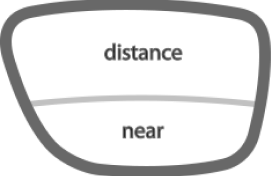Bifocal lenses are eyeglass lenses that have two distinct optical powers, one for distance vision and one for near vision, in a single lens. The two powers are divided by a visible line that runs horizontally across the lens. The upper part of the lens is designed for distance vision, while the lower part is used for reading or close-up tasks. Bifocals were one of the first types of corrective lenses and were developed to help people with both nearsightedness (myopia) and farsightedness (hyperopia) or presbyopia, which is the age-related loss of the ability to focus on close objects. Bifocals are still used today as an option for people who need correction for both distance and near vision but don't want to switch between two pairs of glasses.














